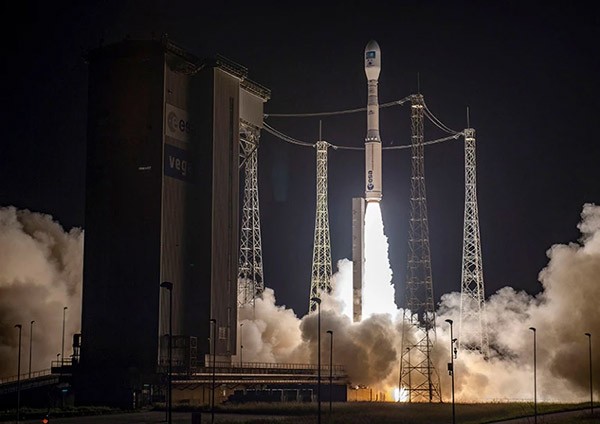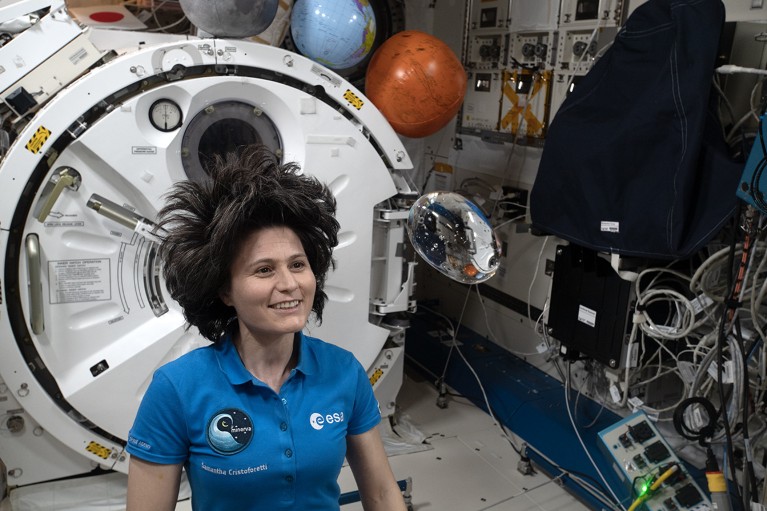Hello Nature readers, would you like to get this Briefing in your inbox free every day? Sign up here
The Vega C rocket failed a few minutes after launching on 20 December. (JM Guillon/AP/Shutterstock)
The Vega C rocket’s launch failure in December could exacerbate the backlog of European Space Agency (ESA) missions. Two satellites were lost in the incident, caused by a faulty nozzle produced in Ukraine. Fifteen flights are now waiting for Vega C and the smaller Vega, which are both grounded until at least later this year. The Euclid space telescope had to be reassigned to lift off from Cape Canaveral, Florida, instead of ESA’s spaceport in French Guyana. “It is not really easy to move a spacecraft from one launcher to another,” says Euclid mission manager Giuseppe Racca, “but we managed.”
France’s minister of higher education and research, Sylvie Retailleau, speaks to Nature about her ambitions for science in France, in her first interview published in English since taking up the post. “My objective is evolution, not revolution,” says Retailleau, who trained as a physicist and took office last May. She describes an as-yet-unveiled plan to pour €7 billion (US$7.4 billion) into health innovation and more funding into ‘risky research’, and how she will find ways to simplify scientists’ lives to allow them to have more time to devote to their work.
A machine-learning algorithm that maps evidence of past or present life could help scientists to find such biosignatures on Mars. Researchers tested the algorithm on a three-square-kilometre area of Chile’s Atacama Desert, where it reduced their search area by up to 97% and increased their likelihood of finding endoliths, a type of rock-dwelling, photosynthetic organism, by up to 88%. “At the end, you could plop us down, and instead of wandering around for a long time, it would take us a minute to find life,” says astrobiologist Kimberley Warren-Rhodes.
Reference: Nature Astronomy paper
Features & opinion
Geologists knew decades ago that a large quake would strike Turkey and Syria, the question was when. Decades of research have shown that it’s probably impossible to predict when a geological fault will start to shake. None of the warning signs that once held promise — isotopes in water, tiny pre-quakes, electromagnetic signals and even odd animal behaviour — has stood up to testing. Faults are “grungy, messy features and they don’t behave as we would like them to”, explains Ross Stein, who heads a seismic-risk-assessment company. “The real focus in most of the world is not on prediction, but on assessing the hazard and the long-term rates of earthquakes,” says geophysicist Susan Hough.
Decolonization of the chemistry curriculum can come in lots of forms: update course material to include contributions from non-Western cultures or researchers, use examples of chemistry that solves a problem in low-income countries or ask students to reflect on where the papers they cite were produced. Teaching reactions, without focusing on the names of the people credited with discovering them, encourages students to think more deeply about chemical reactivity. Importantly, says chemist Kelechi Uleanya, these efforts have “nothing to do with losing the chemistry we have”, but rather about including things to make the science more global.
Scientists with vision loss face many hurdles, from poorly formatted PDFs that can’t be understood by screen readers to a widespread emphasis on visual presentation. “The overarching challenge is that content is visually designed,” says JooYoung Seo, the first blind scientist to be a certified instructor for the popular ‘tidyverse’ data-science package. “But visualization is only one of the representation methods. We can represent data in multimodal ways.” Among the tools that researchers have created to help include a screen-reader interface for figures and textured print-outs that both blind and sighted scientists can use.
When computational chemist Andrew White spotted that there was no protein emoji, he joined up with other scientists to submit their own. “Emojis are part and parcel of how we communicate now, and I think they’re an important addition to the arsenal of science communicators,” he says. White’s proposal didn’t make the cut, but he explains the procedure in case you want to try it yourself.
Where I work
Samantha Cristoforetti is a European Space Agency astronaut who lives in Cologne, Germany.Credit: ESA/NASA
On board the International Space Station, astronaut Samantha Cristoforetti is having a zero-gravity water ‘play date’: “Surface tension keeps the water bubble together, and you can move it by using a straw to pull on it gently, or by blowing on it. If the bubble is small enough, you can drink it.” Weightlessness is an opportunity to study fundamental physics, she explains, such as sloshing behaviour of fluids and gases in containers. The results are important for designing fuel tanks — both for use in space and on Earth. (Nature | 3 min read) (ESA/NASA)
Today I enjoyed learning about Iceland’s Puffling Patrol: youngsters in Vestmannaeyjabaer, a town on a tiny island off the southern coast. Their archipelago is home to the world’s largest colony of Atlantic puffins, and if any pufflings get confused by artificial lights on their first flight after leaving the burrow, the town’s kids are tasked with saving them (by chucking them off a sea cliff, where they belong).
Help keep this newsletter on the right track by telling us your feedback. Your e-mails are always welcome at [email protected].
Thanks for reading,
Flora Graham, senior editor, Nature Briefing
With contributions by Katrina Krämer and Smriti Mallapaty
We’ve recently launched two new e-mails you might like. They’re free, and of course you can unsubscribe at any time.
• Nature Briefing: Cancer — a new weekly newsletter written with cancer researchers in mind. Sign up here to receive the next one.
• Nature Briefing: Translational Research covers biotechnology, drug discovery and pharma. Sign up here to get it free in your inbox each week.









More News
Star Formation Shut Down by Multiphase Gas Outflow in a Galaxy at a Redshift of 2.45 – Nature
Garden-variety fungus is an expert at environmental clean-ups
Air-travel climate-change emissions detailed for nearly 200 nations